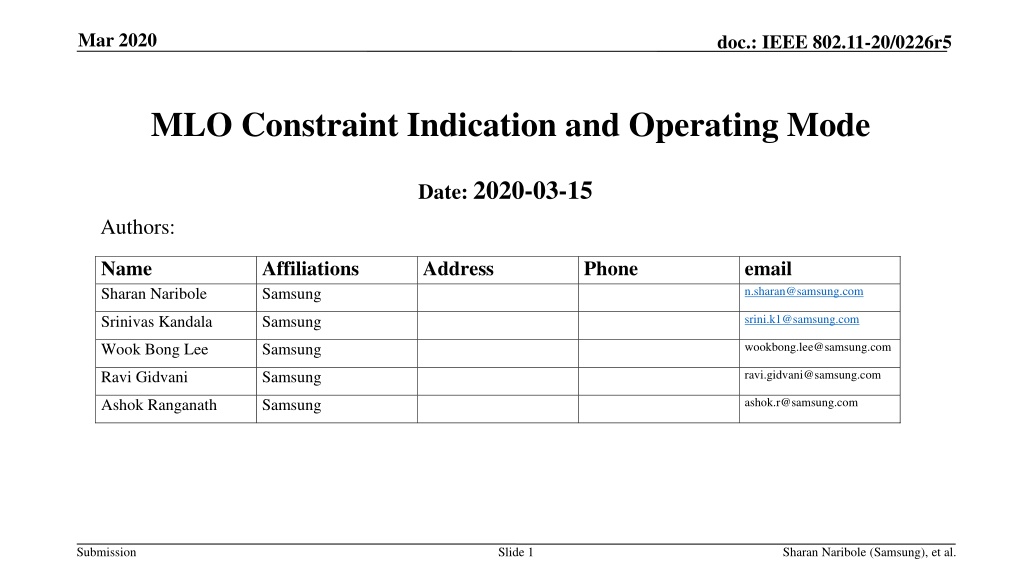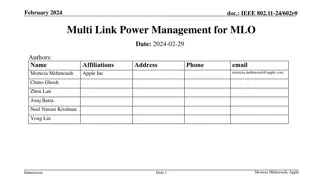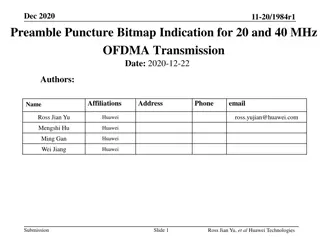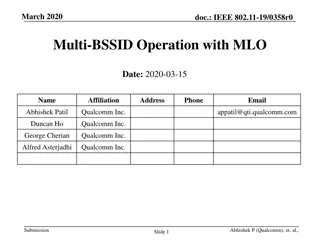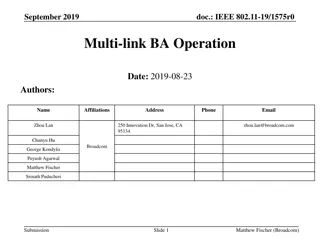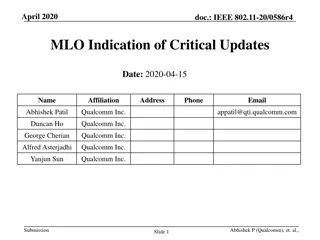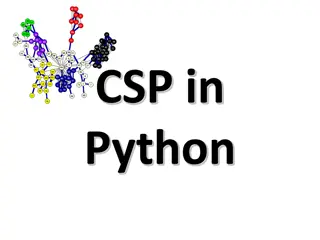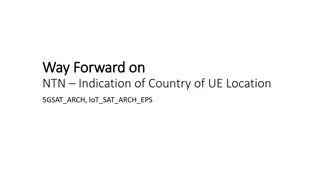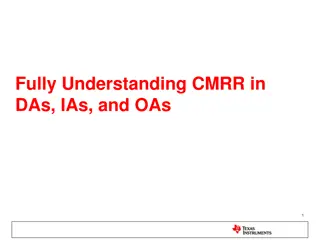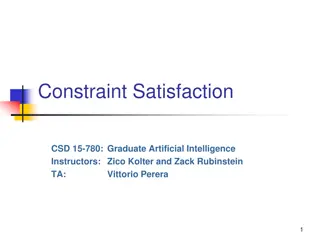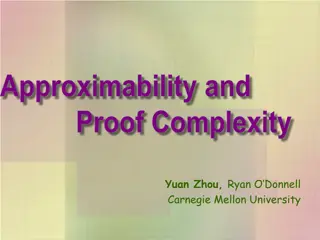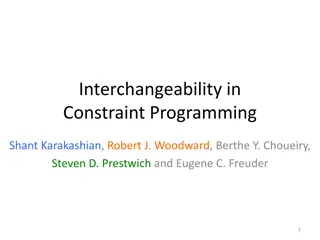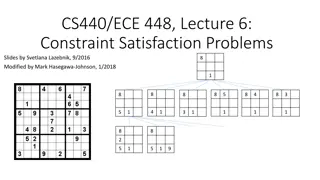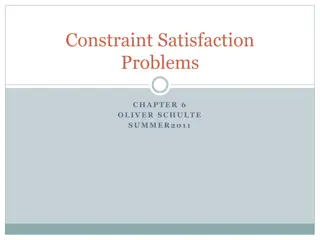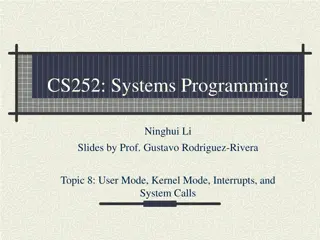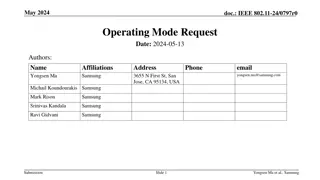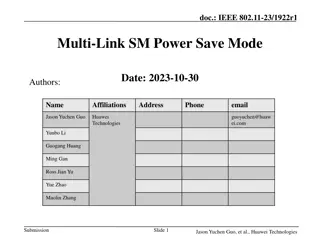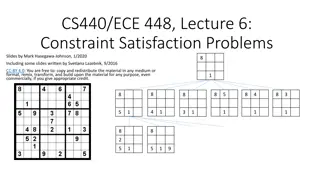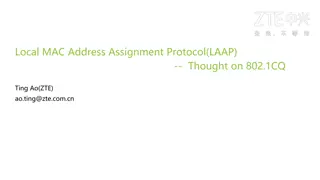MLO Constraint Indication and Operating Mode
This document discusses multi-link operation constraints and operating modes in the IEEE 802.11be standard development, focusing on link management, in-device operation constraints, dynamic link status updates, and more
Download Presentation

Please find below an Image/Link to download the presentation.
The content on the website is provided AS IS for your information and personal use only. It may not be sold, licensed, or shared on other websites without obtaining consent from the author.If you encounter any issues during the download, it is possible that the publisher has removed the file from their server.
You are allowed to download the files provided on this website for personal or commercial use, subject to the condition that they are used lawfully. All files are the property of their respective owners.
The content on the website is provided AS IS for your information and personal use only. It may not be sold, licensed, or shared on other websites without obtaining consent from the author.
E N D
Presentation Transcript
Mar 2020 doc.: IEEE 802.11-20/0226r5 MLO Constraint Indication and Operating Mode Date:2020-03-15 Authors: Name Sharan Naribole Affiliations Samsung Address Phone email n.sharan@samsung.com srini.k1@samsung.com Srinivas Kandala Samsung wookbong.lee@samsung.com Wook Bong Lee Samsung ravi.gidvani@samsung.com Ravi Gidvani Samsung ashok.r@samsung.com Ashok Ranganath Samsung Submission Slide 1 Sharan Naribole (Samsung), et al.
Mar 2020 doc.: IEEE 802.11-20/0226r5 Introduction Multi-link operation is a key feature of the 802.11be standard development Several discussions and motions on link management and in-device operation constraints Multi-link Management o Concept of link enable/disable o Multi-link power saving Operation Constraints o MLDs with constraint to perform simultaneous transmit-receive operation (non-STR) In this contribution, we discuss multi-link operating mode of non-AP MLD and updates under various network conditions o Dynamic link status update and potential latency, BSS parameter updates on disabled links, link operation and constraint update for channel switching Submission Slide 2 Sharan Naribole (Samsung), et al.
Mar 2020 doc.: IEEE 802.11-20/0226r5 Link Management Recap [1] By default, after multi-link setup, all TIDs are mapped to all setup links. The TID-to-link mapping can be updated after multi-link setup through a negotiation, which can be initiated by any MLD. o NOTE: When the responding MLD cannot accept the update, it can reject the TID-to-link mapping update A link, that is setup as part of a multi-link setup, is defined as Enabled if that link can be used for frame exchange and at least one TID is mapped to that link. o NOTE Frame exchange on a link is subject to the power state of the corresponding non-AP STA. A non-AP MLD monitors and performs basic operations (such as traffic indication, BSS parameter updates, etc.) on one or more link(s). Submission Slide 3 Sharan Naribole (Samsung), et al.
Mar 2020 doc.: IEEE 802.11-20/0226r5 STR Constraint Recap [1,2] 802.11be shall allow a MLD that has constraints to simultaneously transmit and receive on a pair of links to operate over this pair of links. A MLD that supports multiple links can announce whether it can support transmission on one link concurrent with reception on the other link for each pair of links. o NOTE 1 The 2 links are on different channels. o NOTE 2 Whether to define a capability of announcing the support transmission on one link concurrent with transmission on the other link is TBD. Submission Slide 4 Sharan Naribole (Samsung), et al.
Mar 2020 doc.: IEEE 802.11-20/0226r5 Multi-link BSS Management AP MLD establishes BSS on multiple links distributed over multiple bands An interested non-AP MLD can perform ML Setup on a subset of links operated by AP MLD Among the setup links, the set of enabled links for frame exchange can update dynamically For an associated non-AP MLD, AP MLD maintains Enabled Link Set ( TID-to-link map ) For the Enabled Link Set, AP MLD maintains pairwise STR capability of the non-AP MLD Simplistic snapshot of info stored at AP MLD operating on links A, B, C and D o AP MLD has STR capability on every pair of links Non-AP MLD Setup Links Enabled Link Set {A, B} STR Capability Info of non-AP MLD at AP MLD {A-B: STR} Device 1 {A, B, D} Device 2 {A, B, C} {A, B, C} {A-B: STR, B-C: Non-STR, A-C: STR} Submission Slide 5 Sharan Naribole (Samsung), et al.
Mar 2020 doc.: IEEE 802.11-20/0226r5 STR Capability Information STR capability on a link pair depends on design, implementation and operation o Channel separation, operating BW on each channel, bands of operation, antenna distribution across links (all antennas for all links, separate antennas per link, ..), etc. Contents provided by non-AP MLD during multi-link setup can be of varying levels Simplistic option o Bit indication of pairwise STR capability between the specific channels used by AP MLD Coarse-grained example o Simple bit indication for STR Capability across multiple bands e.g. 2.4G-5G, 5G-6G, etc. Fine-grained example o Minimum frequency separation to be STR capable Dimensions: link bandwidth, transmit power Submission Slide 6 Sharan Naribole (Samsung), et al.
Mar 2020 doc.: IEEE 802.11-20/0226r5 STR Capability Update Questionable benefit of providing fine-grained information as the non-AP MLD s operating mode and therefore STR capability is time-variant Therefore, it would be beneficial to define mechanism for non-AP MLD to update STR capability of any pair of enabled/setup links even after initial multi-link setup STR Capability update mechanism can be similar to Operating Mode indication in 802.11ax. We can define new field similar to 802.11ax OM Control To facilitate fast transition of non-AP MLDs from STR mode to non-STR mode and vice versa and take advantage of multi-link channel access, this operating mode update of any pair of enabled/setup links by non-AP MLD shall be allowed to perform on any of the enabled links Submission Slide 7 Sharan Naribole (Samsung), et al.
Mar 2020 doc.: IEEE 802.11-20/0226r5 Dynamic Link Enable/Disable Non-AP MLD may enable/disable any of the setup links dynamically o Power save o Link switching o Co-existence with other technologies o In-device constraints o Traffic changes o Channel switch by AP STA o Recommendation by AP MLD o Et cetera For simplicity, we denote the update of the set of enabled links as Enabled Link Set Update Submission Slide 8 Sharan Naribole (Samsung), et al.
Mar 2020 doc.: IEEE 802.11-20/0226r5 Dynamic Link Set Update Mechanism Enabled Link Set Update mechanism can be similar to Operating Mode indication in 802.11ax. We can define new EHT Control field similar to 802.11ax OM Control. To facilitate fast transition and take advantage of multi-link channel access, Enabled Link Set update by non-AP MLD shall be allowed to perform on any of the enabled links Submission Slide 9 Sharan Naribole (Samsung), et al.
Mar 2020 doc.: IEEE 802.11-20/0226r5 Dynamic Link Set Update Proposed Rules Enabled Link Set update initiated from non-AP MLD can be to enable or disable link(s) Link Enabled to Disabled o Non-AP MLD may not want or not be able to exchange frames on link temporarily Link Disabled to Enabled o Non-AP MLD intends to re-enable a setup link that was temporarily disabled. However, AP MLD may reject the request e.g. load balancing AP MLD rejecting updates initiated by non-AP MLD can limit non-AP MLD s preferred operating mode and degrade performance Admission control, in reference to operation on a link, can be performed by AP MLD during the multi-link setup phase AP MLD shall not reject Enabled Link Set update (TID-to-link mapping) update initiated by non-AP MLD Submission Slide 10 Sharan Naribole (Samsung), et al.
Mar 2020 doc.: IEEE 802.11-20/0226r5 Disabling a Link with AP MLDs Prior to the disabling of a link by non-AP MLD, AP on that link might have frames queued for the corresponding non-AP STA o Trigger frames, data, etc. Similar to existing problem in legacy WLANs as non-AP STA switches to PM = 1 mode Even after non-AP MLD sends Enabled Link Set update frame indicating a link to be disabled, AP might transmit on that link o Asynchronous multi-link operation Disable link A message transmitted by non-AP MLD on link B o In-device coordination latency at AP MLD Submission Slide 11 Sharan Naribole (Samsung), et al.
Mar 2020 doc.: IEEE 802.11-20/0226r5 Disabling a Link with AP MLDs Proposal Option 1: Require AP MLD to transmit explicit Disabled Link acknowledgement for Enabled Link Set update ( TID-to-link mapping update) that results in a disabled link o Non-AP MLD shall continue to monitor the disabled link until receiving this explicit acknowledgement o Disabled link acknowledgement can be transmitted from AP on any link that is enabled prior to transmission of this frame Submission Slide 12 Sharan Naribole (Samsung), et al.
Mar 2020 doc.: IEEE 802.11-20/0226r5 Disabling a Link with AP MLDs Proposal Option 2: AP MLD can provide a pre-defined timer value to non-AP MLD during multi- link setup as the wait time to disable a link. o After non-AP MLD transmits the EMT OM Control message to disable a link, the timer countdown begins o During the countdown, the non-AP MLD continues to monitor the link but does not initiate any frame exchanges o After the timer expiry, the link is considered disabled by both AP MLD and non-AP MLD Submission Slide 13 Sharan Naribole (Samsung), et al.
Mar 2020 doc.: IEEE 802.11-20/0226r5 BSS Parameters Update on Disabled Link During the temporary disabled state of a link, BSS Parameters of this link may get updated To avoid Beacon bloating, AP MLD might not include the complete set of BSS operating parameters of one link in the Beacons or Probe Responses sent on other link o Even including just the updated BSS parameters can be significant due to repetition Essential information such as operating channel, primary 20 MHz of other link should be still included to aid in multi-link discovery and in case of channel switch when the link is disabled When a disabled link is re-enabled, the non-AP MLD would have to wait until receiving Probe Response or Beacon for updated BSS parameters before it can initiate frame exchanges Highly desirable for non-AP MLD to perform fast transitions into updated Enabled Link Set and perform frame exchanges Submission Slide 14 Sharan Naribole (Samsung), et al.
Mar 2020 doc.: IEEE 802.11-20/0226r5 Option 1: BSS Parameter Update Notification In the same message to disable a link, non-AP MLD requests for notification from the AP MLD if the BSS Parameters of this link get updated during the disabled status When BSS Parameters of a disabled link get updated, AP MLD includes notification in unicast transmissions to this non-AP MLD on other enabled links o A single bit is sufficient to indicate update has taken place Assisted by the AP s notification, Non-AP MLD can monitor Beacon/ Probe Responses of a disabled link prior to re-enabling of that link Cons: AP MLD needs to maintain snapshot of BSS Parameters of setup links at the time of disabling a link and notify non-AP MLD when there is BSS Parameters update Submission Slide 15 Sharan Naribole (Samsung), et al.
Mar 2020 doc.: IEEE 802.11-20/0226r5 Option 2: Per-link BSS Parameter Version ID AP of an AP MLD includes in its Beacons and Probe Responses the Version ID of the BSS Parameters of other AP(s) belonging to this AP MLD e.g. in EHT Operation, ML IE, etc. The complete set of BSS Parameters or even the updated parameters need not be included Size of Version ID is TBD In contrast to Option 1, AP MLD does not need to maintain snapshot of BSS Parameters for each non-AP MLD s enabled link set update AP can also include this Version ID information in EHT Control of unicast transmissions Can also be utilized by non-AP MLDs with active TWT sessions on one or more links o Do not need to wake up for Beacon if Version ID of TWT link is not changed In both options 1 and 2, non-AP MLD, upon receiving notification that the BSS parameters of disabled link have updated, can use existing mechanisms such as ANQP query on the enabled link to receive updated BSS parameters of disabled link Submission Slide 16 Sharan Naribole (Samsung), et al.
Mar 2020 doc.: IEEE 802.11-20/0226r5 Channel Switch in Multi-link BSS Context AP MLD may switch the channel of a link over time to a new spectrum o interference conditions, load balancing, co-existence e.g. radar DFS channels in 5 GHz Non-AP MLD might not be able to operate on new channel after switch o In-device co-existence e.g. peer-to-peer traffic, UWB in 6 GHz, etc. STR capability on a link pair is dependent on several factors of implementation o Channel separation, operating BW on each channel, bands of operation, antenna distribution across links (all antennas for all links, separate antennas per link, ..), etc. o Static STR capability map provided during multi-link setup would be insufficient After channel switch on a link, AP MLD needs to update for an associated non-AP MLD o Enable/disable state of this link o If link still enabled, pairwise STR capability of this link with other enabled links Submission Slide 17 Sharan Naribole (Samsung), et al.
Mar 2020 doc.: IEEE 802.11-20/0226r5 Potential Link Management Mechanisms for Channel Switch Option 1: No Implicit Update by AP MLD of link status and STR cap. of non-AP MLD o AP MLD does not perform any implicit update o Non-AP MLD can explicitly disable link after receiving Channel Switch Announcement Non-AP MLD can request update of enabled link set using any enabled link o If switched link still enabled, non-AP MLD can provide updated STR capability information o Non-AP MLD shall be allowed to provide STR capability information using any enabled link Option 2: Link Disabled by AP MLD after Channel Switch o AP MLD disables the link in UL and DL for associated non-AP MLDs after channel switch o In case, a TID is mapped to just the link undergoing channel switch The TID shall be remapped to all other enabled links o Non-AP MLD can explicitly request to enable this link and indicate STR capability information o This information can be provided before the channel switch and link disabling by AP MLD o Typically, channel switch is performed after several TBTTs o If provided before the channel switch, AP MLD shall not disable the link for the non-AP MLD STR Capability information can be included in uplink transmissions in EHT Control Submission Slide 18 Sharan Naribole (Samsung), et al.
Mar 2020 doc.: IEEE 802.11-20/0226r5 Summary AP MLD maintains enabled link set and link-pairwise STR capability of non-AP MLDs Non-AP MLD can dynamically update STR capability and Enabled Link Set for different reasons Proposed rules for Enabled Link Set update initiated by non-AP MLD including disabling of link Proposed AP MLD notifying BSS Parameters update of disabled links using Version ID Proposed link management mechanisms and updated STR Capability information for channel switch events Submission Slide 19 Sharan Naribole (Samsung), et al.
Mar 2020 doc.: IEEE 802.11-20/0226r5 Simultaneous Transmit and Receive (STR) Update - Recap A MLD that supports multiple links can announce whether it can support transmission on one link concurrent with reception on the other link for each pair of links. - NOTE 1 The 2 links are on different channels. NOTE 2 Whether to define a capability of announcing the support transmission on one link concurrent with transmission on the other link is TBD. [Motion 38, [3] and [37]] Not mentioned if such announcement by non-AP MLD can be performed only during initial multi- link setup or even after. Support for STR operation on a link pair depends on design and BSS operation o Channel separation, operating BW on each channel, bands of operation, transmit power, etc. o Antenna distribution across links (all antennas for all links, separate antennas per link, ..), etc. Beneficial to allow non-AP MLD to indicate any change in its support for STR operation for a pair of setup links even after setup. Otherwise, the non-AP MLD has to teardown the ML setup and re- do the entire setup with updated support for STR operation. This would lead to significant overhead and disruption in multi-link operation. Submission Slide 20 Sharan Naribole (Samsung), et al.
Mar 2020 doc.: IEEE 802.11-20/0226r5 Straw Poll #1 Do you support the addition of the following text to TGbe SFD? A non-AP MLD may update its ability to perform simultaneous transmission and reception on a pair of setup links after multi-link setup. o This update for any pair of setup links can be announced by non-AP MLD on any enabled link. NOTE Specific signaling for update indication is TBD NOTE - Limitations on dynamic updating is TBD Y/N/A: 43/7/29 Submission Slide 21 Sharan Naribole (Samsung), et al.
Mar 2020 doc.: IEEE 802.11-20/0226r5 Straw Poll #2 Do you support the addition of following text to the TGbe SFD? STR: simultaneous transmission on one link and reception on other link STR operation, by an MLD in reference to a pair of links, is defined as the operation in which the MLD has the ability to support reception on one link while simultaneously transmitting on the other link. o NOTE - Specific requirements is TBD Non-STR operation, by an MLD in reference to a pair of links, is defined as the operation in which the MLD does not have the ability to support reception on one link while simultaneously transmitting on the other link. o NOTE - Specific constraints indicated is TBD Submission Slide 22 Sharan Naribole (Samsung), et al.
Mar 2020 doc.: IEEE 802.11-20/0226r5 Straw Poll #4 Do you support the addition of following text to the TGbe SFD? TID-to-link mapping update can be performed on any enabled link. Submission Slide 23 Sharan Naribole (Samsung), et al.
Mar 2020 doc.: IEEE 802.11-20/0226r5 Straw Poll #5 Do you support the addition of following text to the TGbe SFD? An AP MLD shall not reject TID-to-link mapping update initiated by an non-AP MLD intending to disable a link or links Submission Slide 24 Sharan Naribole (Samsung), et al.
Mar 2020 doc.: IEEE 802.11-20/0226r5 Straw Poll #6 Do you support the addition of following text to the TGbe SFD? An AP MLD should not reject TID-to-link mapping update initiated by an non-AP MLD intending to enable a link or links Submission Slide 25 Sharan Naribole (Samsung), et al.
Mar 2020 doc.: IEEE 802.11-20/0226r5 Straw Poll #7 Do you support the following mechanism to be defined in 802.11be? An AP MLD can include in its Beacons and Probe Responses the Version ID of the BSS Parameters set of another AP part of this AP MLD Submission Slide 26 Sharan Naribole (Samsung), et al.
Mar 2020 doc.: IEEE 802.11-20/0226r5 Straw Poll #8 Which of the following options do you support as default multi-link management mechanism to be used by AP MLD performing channel switch on a link? o Option 1: No Implicit Update by AP MLD of link status and STR cap. of non-AP MLD (details in Slide 15) o Option 2: Link Disabled by AP MLD after Channel Switch(details in Slide 15) o Abstain Submission Slide 27 Sharan Naribole (Samsung), et al.
Mar 2020 doc.: IEEE 802.11-20/0226r5 References [1] 11-19-1262-07-00be-specification-framework-for-tgbe [2] 11-19-1405-07-00be-multi-link-operation-channel-access-discussion Submission Slide 28 Sharan Naribole (Samsung), et al.
